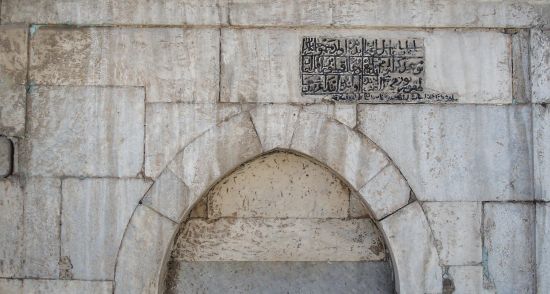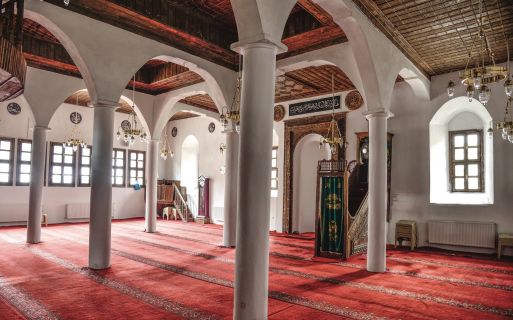ALACA MOSQUE
Turkiye AFYON
The mosque is located at the junction of İstasyon and Hacı Mahmut Streets in the neighbourhood of the same name in the district of Bolvadin. The almost-square rectangular prayer hall extends in the east-west direction and surmounted with a pitched roof with modern tiles. The joining lines of the roof are covered with round tiles. As the street levels have risen in time the east and north façades start from below the street level; on the west, the mosque adjoins a house. A brick minaret with a single balcony rises at the northeast corner.
Known as the Alaca, i.e. colourful, Mosque among locals the monument was originally built as a masjid and transformed to a mosque in the sixteenth century. It has been renovated many times, thus losing most of its authenticity. Certainly, severe earthquakes in the history, particularly those of the nineteenth century, have been the source for these interventions.
Apart from the socle of the minaret, the existing mosque is a product of later periods. All the structural elements of the mosque were replaced in the course of heavy repairs possibly in the mid-twentieth century as well as all the windows, mihrab, minbar (Friday sermon pulpit) and pulpit as well as roof and decoration.
In this context, it can be stated that the minaret’s socle at the northeast corner is the only original part surviving from the original monument which was transformed to a mosque in the Ottoman period. This point can also be verified with a detail still discernible on the tympanum of the low-arched doorway within a pointed-arched niche on the east façade of the socle. The tympanum is formed with two marble blocks placed horizontally; where they join the intrados on the south is a triangular baked clay piece shaped following the curve of the arch. The baked clay piece still bears traces of dark blue glaze in situ, thus clearly showing that there was a triangular tile plaque. However, this tile plaque was removed and destroyed just like its symmetrical counterpart and hay-tempered plaster was applied in their places. Despite the lack of any information the colour of the glaze residue suggests tiles of the Ottoman period. Indeed, it is not only the tiles destroyed; on the marble blocks forming the tympanum there are traces indicating painted decoration on plaster, or it may even be suggested that a tile panel facing the entire tympanum was damaged, or removed and smuggled.
Examining the socle of the minaret suggests that the minaret was added during the transformation to a mosque. Remains of a wall mass adjoining the door to the mosque on its south may suggest, hypothetically, that a five-bayed latecomers’ area projecting into the present street was added during the transformation. However, excavations are needed to verify this hypothesis.
Certainly, the most important element of the mosque is the wooden door wing of the minaret’s socle. This door wing comprises two wooden panels joined with a metal belt of circular and rhombic pieces and forged-boss-headed iron nails; it features a pointed arch with carved rumi and palmette motifs. A comparison with similar door wings with pointed-arch compositions it can be ascribed to the thirteenth century in the Seljuk period. The anomaly observed in its placement to the minaret door clearly shows that this door wing was not designed for this door; perhaps it belonged to the previous masjid and reused here after the transformation.
An inscription in Turkish over the pointed arch on the east side of the minaret’s socle is the only written evidence for this mosque. The three-line inscription states that the masjid was transformed to a mosque in the beginning of the month of Shaban in AH 965 (19 May 1558 Thursday) in the reign of Süleyman the Magnificent.
AFYON



